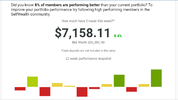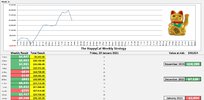- Joined
- 3 January 2021
- Posts
- 47
- Reactions
- 106
I have been and continue to be interested in what @Skate calls his "Stale" stop-loss. I had no idea how to code such a thing, but the idea seems sound. I currently have a few stocks that initially trended strongly higher, but currently are operating in a range. They do seem stale.
I'm trading Weekend Trend Trader which uses 20 week break-outs. I code Donchian(20) channels to visualize that.
In a happy accident, today I noticed that the upper Donchian channel for Amazon had turned lower. So there has been no new high for 20 weeks. This seems to be a reasonable test of staleness for my WTT strategy.
I will definitely code this up and backtest to see whether it acts as an improvement over the existing system.

I'm trading Weekend Trend Trader which uses 20 week break-outs. I code Donchian(20) channels to visualize that.
In a happy accident, today I noticed that the upper Donchian channel for Amazon had turned lower. So there has been no new high for 20 weeks. This seems to be a reasonable test of staleness for my WTT strategy.
I will definitely code this up and backtest to see whether it acts as an improvement over the existing system.









